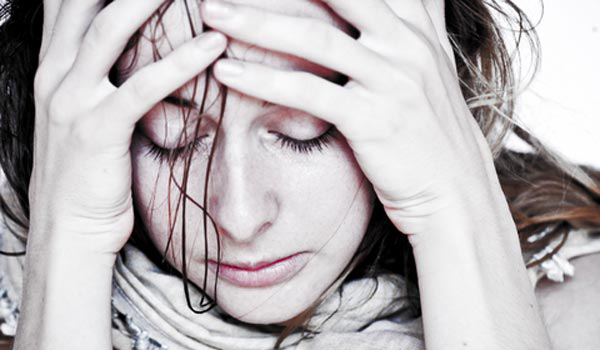Nobel Scientist's Claim Examined: Do Women Actually Cry More?

The world recoiled as soon as it heard Nobel Laureate Tim Hunt's now infamous quote about women in science: "Three things happen when they are in the lab: You fall in love with them, they fall in love with you, and when you criticize them they cry."
Although the general consensus is that Hunt was completely out of line, studies show that overall, women do cry more than men — though not, as Hunt claimed, because they can't take criticism, but because of various biological, social and environmental factors. Overall, science has plenty to say about sex differences in crying and why humans are unique in shedding emotionally charged tears.
#distractinglysexy
Hunt, who won the 2001 Nobel Prize in physiology or medicine, shared his sentiments on Monday (June 8) at the World Conferences of Science Journalists in South Korea. His audience wasted no time in disseminating this news, leading to his resignation as honorary professor at University College London in the United Kingdom, and the launch of #distractinglysexy on Twitter.
Amy Remeikis, a political editor at the Brisbane Times in Australia, posted a picture on Twitter of French scientist Marie Curie with the caption: "I'm really glad that Curie managed to take a break from crying to discover radium and polonium #distractinglysexy." [12 Amazing Women Who Totally Rocked at Science]
And Steve Diggle, a microbiologist at the University of Nottingham in the United Kingdom, created a yellow caution sign that said, "Mixed gender lab! No falling in love or crying permitted," and posted it on Twitter.
The reaction is not without good reason: Female scientists still face challenges in the workplace, and comments like Hunt's reinforce archaic feminine stereotypes, such as that of a weeping woman, experts say.
Sign up for the Live Science daily newsletter now
Get the world’s most fascinating discoveries delivered straight to your inbox.
Tearful science
Psychological studies have found that on average, women cry two to five times a month, or three to five times more often than men, according to research reported by psychologists Ivan Nyklicek, Lydia Temoshok and Ad Vingerhoets, all of Tilburg University in the Netherlands, in the book "Emotional Expression and Health" (Routledge, 2004). The crying discrepancy is prevalent regardless of country, indicating different hormonal signals, though certain countries have a wider gap than others, pointing to cultural effects as well.
"Traditionally, men's roles in Western societies can be characterized as being independent, in control, and solving problems rationally, whereas women's roles are being dependent on others, emotional, and relational," write Nyklicek, Temoshok and Vingerhoets. And when men do shed their manly tears, they likely express pride, bravery, allegiance, triumph and defeat, the trio wrote.
When researchers, whose work is cited in the book, looked specifically at these manly sobs from both Dutch men and women after the Netherlands' loss in the semifinal of the World Cup in France in 1998, they found that more women than men cried. Furthermore, 20 percent of women and 8 percent of men admitted to crying during an Olympic ceremony, and only 12 percent of women and 5 percent of men admitted to crying while watching a news report on a deadly fire. Proportionally, more women than men cried during a "more masculine" cry fest. [10 Surprising Facts About a Woman's Body]
Overall, men and women cry over the same things, like the death of a loved one, romantic breakups and homesickness. Women may cry more over smaller events, like a fight or computer crash, but, "Remarkably, men cry relatively more often in reaction to positive events," Vingerhoets told LiveScience in an email.
Women tend to seek leisure activities that make them feel sad, "because of a certain pleasure in the experience of feeling moved to tears,” Vingerhoets and psychology professor Randolph Cornelius of Vassar College write in their book "Adult Crying: A Biopsychosocial Approach" (Routledge, 2012). Soap operas command a relatively larger female viewership, and have a "high tear eliciting capacity," they wrote. "Consider the differences in the kinds of movies and the kinds of books and literature that men and women consume. If a woman watches a tear jerker once a week, while her male partner is working on his car or playing billiards, the difference is already explained. But there is more," Vingerhoets said.
Why women cry more
People's professions may play a role in crying differences between the sexes. Women dominate nursing positions, which could present more emotional situations, whereas men tend to go into more technical fields, which likely present fewer opportunities to express emotion, according to Vingerhoets and Cornelius.
Location could also predict when differences between men and women's crying frequency are more pronounced. Charles Darwin first noted that crying in Western cultures, particular his home country of England, was much less common than in non-Western cultures. Clinical studies in the early 1980s, over 70 years after Darwin's observation, found that American men and women cried about twice as much as Hungarian men and women.
In 37 countries across the world women cry more than men, "although there were some (mainly African) countries where the differences were minimal." Vingerhoets said. Countries that allow greater freedom of expression and social resources, like Chile, Sweden and the United States saw bigger sex gaps in sobs, and countries with more suppressive regimes, like Ghana, Nigeria and Nepal, reported a much smaller gap in crying, according to a 2011 study by Dianne van Hemert of the Netherlands Organization for Applied Scientific Research and colleagues in the journal Cross-Cultural Research.
Regardless of where you are or what you do, differences in crying between men and women can also occur because of biology – more specifically, hormone levels. A study from 2012 found that women have 60 percent more prolactin, which is a reproductive hormone that stimulates the production of milk in women after childbirth, than the average male. Emotional tears are especially high in prolactin, which could explain why women cry more often than men.
Testosterone levels, too, can stop men from crying. Men who are treated with prostate cancer drugs see reduced testosterone levels and are more likely to cry because testosterone seems to have an inhibiting influence on crying, Vingerhoets said.
As for why humans cry, a slew of ideas have been put forth, including that tears release stressful chemicals, they makes people feel better, signal health problems in babies, or even by blurring vision, tears lower a person's defenses, signaling submission. If a woman were to cry behind a beaker or graduated cylinder, a mere whiff of those tears could lower a nearby male's sexual desire, according to a study detailed in the journal Science in 2011 that suggested human tears hold a chemosignal.
Apparently, Hunt thinks science can do without crying: After the angry response to his comments, Hunt said, "It's terribly important that you can criticize people's ideas without criticizing them and if they burst into tears, it means that you tend to hold back from getting at the absolute truth," he said. "Science is about nothing but getting at the truth, and anything that gets in the way of that diminishes, in my experience, the science."
Elizabeth Goldbaum is on Twitter. Follow Live Science @livescience, Facebook & Google+. Original article on Live Science










